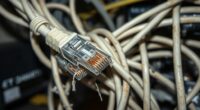Serial cables like RS-232 and RS-485 are essential tools for connecting hardware devices and ensuring reliable data transfer. RS-232 uses DB9 or DB25 connectors for short-distance communication, ideal for peripherals like printers and modems. RS-485 supports longer distances and multiple devices, making it perfect for industrial settings. Understanding their differences helps you choose the right cable for your needs, and exploring further reveals how to optimize your connections effectively.
Key Takeaways
- Serial cables enable sequential data transfer between hardware devices, supporting communication protocols like RS‑232 and RS‑485.
- RS‑232 uses DB9 or DB25 connectors, suitable for short-distance, point-to-point connections such as computers and modems.
- RS‑485 allows multi-drop setups over longer distances with differential signaling, ideal for industrial and automation applications.
- Limitations of RS‑232 include lower data rates and susceptibility to electrical noise, making it less suitable for extended or noisy environments.
- Choosing the appropriate serial cable depends on application needs, including distance, number of devices, and environmental conditions.

Have you ever wondered how devices like computers, printers, and modems connect and communicate? The answer lies in serial cables, which facilitate data transfer between different hardware components. These cables enable one device to send and receive data sequentially, bit by bit, over a single channel. Understanding how serial communication works involves knowing about connector types, which are essential for establishing reliable connections. The most common serial connectors include RS‑232 and RS‑485, each suited for specific applications and offering distinct advantages.
When you’re setting up a serial connection, selecting the right connector type is crucial. RS‑232 connectors are typically DB9 or DB25 ports, featuring a series of pins that carry data, control signals, and grounding. These connectors are user-friendly and widely supported by older and some current equipment, making them a popular choice for short-distance communication. Their design emphasizes simplicity, but they are limited in terms of data rates and cable length, usually up to 50 feet at moderate speeds. The connectors are usually male or female, with the male pins plugging into corresponding female ports. Ensuring proper pin alignment and secure connections is vital for smooth data transfer and avoiding communication errors.
On the other hand, RS‑485 uses different connector types, often terminal blocks or RJ45 jacks, suitable for industrial environments and longer distances. Unlike RS‑232, RS‑485 supports multi-drop configurations, meaning multiple devices can share a single communication line. This makes it ideal for building automation, industrial control systems, and data acquisition networks. The connectors for RS‑485 are designed to be robust, with shielded cables to minimize electromagnetic interference, enhancing data transfer reliability over extended runs. These connectors facilitate differential signaling, which helps protect data integrity even in electrically noisy environments.
In practical terms, choosing between these connector types and protocols depends on your specific needs. If you’re connecting a computer to a modem or serial printer over a short distance, RS‑232 with its DB9 or DB25 ports will likely suffice. For more complex setups requiring multiple devices or longer cable runs, RS‑485 with terminal blocks or RJ45 connectors provides the flexibility and durability you need. Both types of serial cables are fundamental in industrial, commercial, and hobbyist projects, ensuring data transfer remains consistent and dependable.
Frequently Asked Questions
How Do I Choose Between RS-232 and RS-485 Cables?
You should choose RS-232 cables for short-distance, point-to-point connections where signal integrity isn’t heavily affected by interference. Opt for RS-485 cables if you need longer distances or multiple devices on the same network, as they offer better noise immunity and differential signaling. Consider cable shielding to protect against electromagnetic interference, especially in industrial environments. Your choice depends on your distance, network complexity, and the need for reliable data transmission.
What Are the Common Connectors Used for Serial Cables?
Think of serial connectors as the handshake between devices. You’ll often see DB9 and DB25 connectors, reminiscent of classic handshake scenes, with pin configurations that guarantee proper communication. For RS-232, the DB9 is common, while RS-485 sometimes uses terminal blocks or RJ45 connectors. Knowing the connector types helps you pick the right cable, ensuring your devices connect smoothly and communicate effectively.
Can Serial Cables Be Used Over Long Distances?
You can use serial cables over long distances, but you’ll face distance limitations due to signal degradation. To extend the range, use cable shielding to reduce interference and consider using RS‑485, which supports longer distances compared to RS‑232. Keep in mind that signal quality diminishes over distance without proper shielding or repeaters, so plan accordingly to maintain reliable communication.
How Do I Troubleshoot Serial Communication Issues?
Like troubleshooting a vintage Walkman, you gotta check your serial communication carefully. First, confirm your cable shielding is intact to prevent interference, which can mess with signal integrity. Verify all connections are secure and correctly configured. Use a serial communication tester or software diagnostics to identify issues. If problems persist, swap out cables or adjust baud rates. Keeping your setup clean and shielded helps maintain reliable data transfer.
Are There Modern Alternatives to Traditional Serial Cables?
You can explore wireless alternatives like Bluetooth, Wi-Fi, or Zigbee for serial communication, which eliminate cable clutter and provide greater flexibility. Fiber optic solutions also serve as modern options, especially for long-distance, high-speed data transfer with immunity to interference. Both options are reliable, scalable, and suited for different environments, making them excellent replacements for traditional serial cables in many industrial and technical applications.
Conclusion
You never know when you’ll find yourself troubleshooting a device or connecting two systems, and that’s where serial cables come in handy. It’s a bit of a coincidence how these cables, often overlooked, can become your reliable link in unexpected moments. Whether it’s RS-232 or RS-485, understanding their uses can save you time and frustration. So, next time you see one, remember—sometimes, the simplest tools are the ones that make all the difference.









